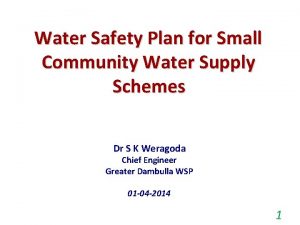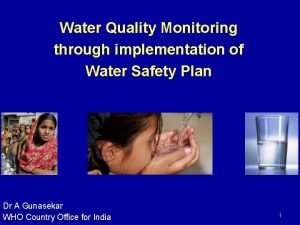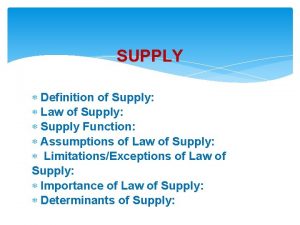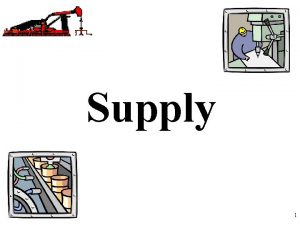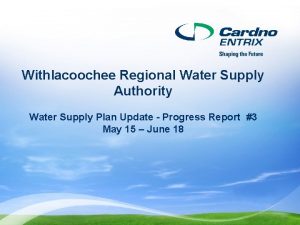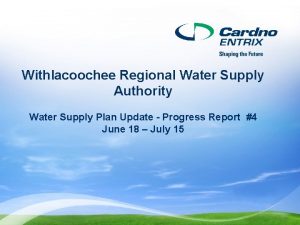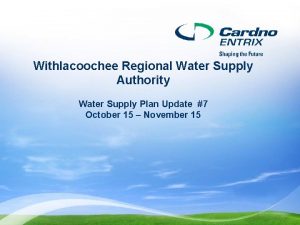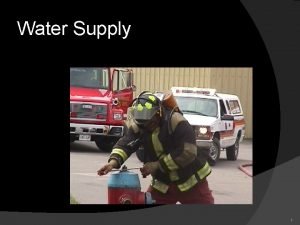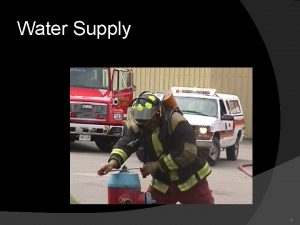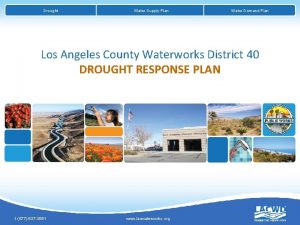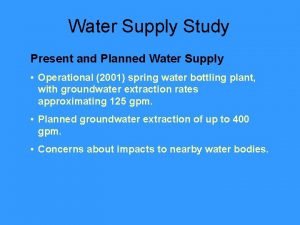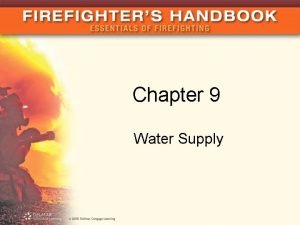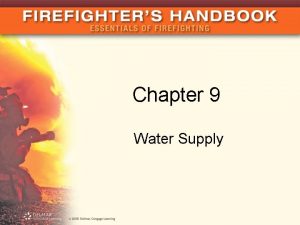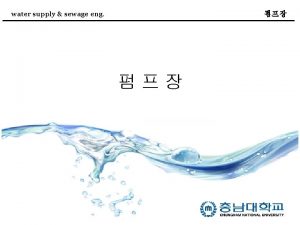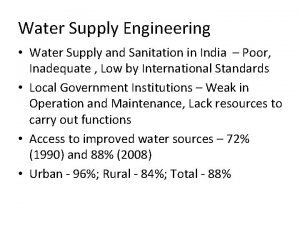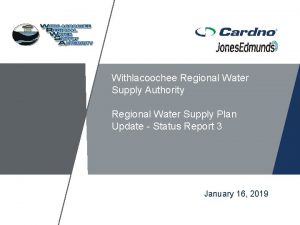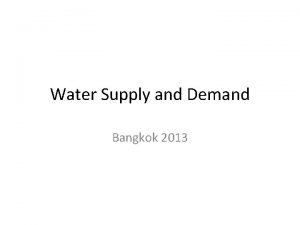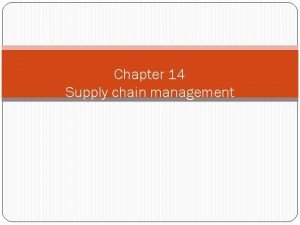Water Safety Plan for Small Community Water Supply



























- Slides: 27

Water Safety Plan for Small Community Water Supply Schemes Dr S K Weragoda Chief Engineer Greater Dambulla WSP 01 -04 -2014 1

Contents • Introduction • History of application in Sri Lanka • Importance of applying WSPs • Basic concepts in application of WSPs 2

Introduction • Water Quality Surveillance or water quality testing is tedious and resource wasting approach in ensuring water quality as testing of sample is key factor. • Application of ISO 9001 in water sector does not consider any impact on water quality before the intake. • Hence, Water Safety Plan (WSP) has become the principal tool to assure safe drinking water (3 rd and 4 th Edition of WHO’s DWA guidelines). 3

WHO Water Safety Framework Health- based targets Public health context & health outcome Water Safety Plans System Assessment Monitoring Management, Documentation & Communication Surveillance 4

From Theory to Best Practice 2003 HACCP principles applied (Iceland, Australia) 2004 WSPs included in WHO GDWQ & IWA Bonn Charter 2004 - 2006 Implementation of WSPs (Uganda, Portugal, Brazil) 2007 WSPs part of E&W regulations 2010 onwards Mainstreamed by utilities, regulators, banks, NGOs 2009 WSP auditing (NZ, Australia, UK) 5

History of Application of WSPs in Sri Lanka • December 2004 tsunami highlighted the need of a proper water surveillance system. • Hepatitis A in 2007 in Gampola has shown the importance of having a proper water quality management system • Understanding the need; – First training on WSP application in Colombo in Year 2010 – APN funded project between Sri Lanka and Singapore in Year 2011 – 2012 – WHO funded training program in Kandy in Year 2013 – Commenced to develop six WSPs 6

How much water in the Human body? 7

Adequate Water Helps Prevent… • • Headaches Constipation Kidney stones Bladder cancer Exhaustion and heat stroke Heart attacks and strokes ………. . 8

If • Quality of the water is ? ? ? …. . • Physical • Biological • Chemical 9

From catchment to end user


From distribution to end user

WSP application in Small Community WSSs • What are small community water supply schemes ? SCWSSs are defined based on their population size, treatment capacity, treatment technology, etc. • What is a water safety plan ? WSP approach is the assessment, prioritization and continuous management of risk to water safety from catchment to consumer. • Why should apply WSPs to SCWSSs? Adopting an incremental improvement plan means that improvements are made over time, moving gradually towards meeting community, local or national water quality targets or objectives. 13

Task 1 – Engage community and assemble a water safety plan team Task 6 – Document, review and improve all aspects of WSP implementation Task 2 – Describe the community water supply Water Safety Plan Continuous Improvement Cycle (For Small Scale WTP) Task 5 – Monitor control measures and verify the effectiveness of the WSP Task 3 – Identify and assess hazards, hazardous events, risk and existing control measures Task 4 – Develop and implement an incremental improvement plan 14

WSP Ehiliyagoda WBMLI Weerasekara, Senior Chemist, Kegalle. 15

WSP committee (Task 01) 1. Regional Level 1. 2. 3. 4. 5. 6. 7. 8. 9. 10. 11. AGM Manager (O&M) RSC Chemist CE(P&D) Regional/Senior Chemist Engineer(O&M) Mechanical Engineer Sociologist OIC Dis. Envi. Committee Catchment Dwellers - Coordinator Member Team Leader Member Member 16

WSP committee con. 2. Top Level 1. 2. 3. 4. 5. 6. 7. GM COL/AGM(WQ) Add. GMM DGMM AGM(Sociology) RSC Chemists Director (Health) - Coordinator Team Leader Member Member 17

WSP Committee • Engaging the community and assembling a WSP team are an essential means to: – identify the community’s aspirations and needs in respect of their water supply, through an inclusive process that considers gender as well as elderly and vulnerable community members; – balance water supply needs against competing communitylevel priorities, such as housing and education; – tap into local knowledge and experience in the identification, assessment and management of risks; 18

WSP Committee • Engaging the community and assembling a WSP team are an essential means to: – identify resources within the community that can be called upon when needed; – initiate a dialogue between the community and other stakeholders (government, NGOs, water service delivery and public health agencies) on the benefits and requirements of a well-functioning water supply and the joint preparation of a WSP; – raise awareness of the role that community members can play in protecting and improving their water supply. 19

Catchment 20

WSP Module 02 (Task 02) 21

WSP Module 3 (Task 03) Hazard and Hazardous Event S Hazard (contaminant) A biological, chemical or physical property which may cause a product to be unsafe for consumption • Biological - bacteria, viruses, protozoa, algae • Chemical – corrosion, pesticides, disinfection by products • Physical – p. H, temperature, discolouration • Radiological S Hazardous Event (cause) • A practice or outcome thatcauses the hazard to become a problem by its introduction into or proliferation in the water product 22

Risk Matrix Likelihood Severity/ Consequences No/ Minor Moderate Major impact Impact Likely Possible Unlikely Medium Low High Medium High : High priority and requires urgent improvement in control measures Medium : Medium or long term priority and requires improvement in control measures in the medium and long term Low : Not a priority 23

Benefits of a WSP • Avoid incidents which impact public health • Improved compliance with regulatory and other requirements • Improved consumer trust • Improved confidence of key stakeholders • Cost effectiveness and investment planning • Improved staff commitment • Competition with peers 24

Global Water Crisis A child dies every 15 seconds from a water-borne disease. 25

But whole world worries about a single plane crash? 26

Thank You 27
 Water and water and water water
Water and water and water water Water safety plan
Water safety plan Water safety plan
Water safety plan Water safety plan
Water safety plan Blood supply small bowel
Blood supply small bowel Chapter 5 section 1 supply and the law of supply
Chapter 5 section 1 supply and the law of supply Uri ng elastisidad ng supply na may parehong bahagdan
Uri ng elastisidad ng supply na may parehong bahagdan Matching supply with demand
Matching supply with demand Fspos vägledning för kontinuitetshantering
Fspos vägledning för kontinuitetshantering Typiska drag för en novell
Typiska drag för en novell Tack för att ni lyssnade bild
Tack för att ni lyssnade bild Ekologiskt fotavtryck
Ekologiskt fotavtryck Varför kallas perioden 1918-1939 för mellankrigstiden?
Varför kallas perioden 1918-1939 för mellankrigstiden? En lathund för arbete med kontinuitetshantering
En lathund för arbete med kontinuitetshantering Underlag för särskild löneskatt på pensionskostnader
Underlag för särskild löneskatt på pensionskostnader Tidbok
Tidbok A gastrica
A gastrica Densitet vatten
Densitet vatten Datorkunskap för nybörjare
Datorkunskap för nybörjare Tack för att ni lyssnade bild
Tack för att ni lyssnade bild Hur skriver man en tes
Hur skriver man en tes För och nackdelar med firo
För och nackdelar med firo Nyckelkompetenser för livslångt lärande
Nyckelkompetenser för livslångt lärande Påbyggnader för flakfordon
Påbyggnader för flakfordon Tryck formel
Tryck formel Offentlig förvaltning
Offentlig förvaltning Kyssande vind analys
Kyssande vind analys Presentera för publik crossboss
Presentera för publik crossboss

